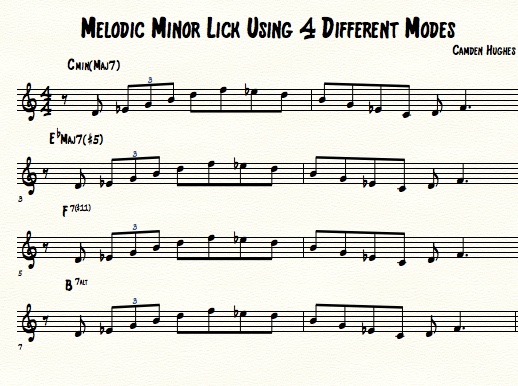

Playing through these triads a few times will also help outline the brightness of the scale. The resulting harmonic pattern is Cm–Dm–Ebaug–F–G–Adim–Bdim. This linear view of the triads helps me see how each one is related to one another. Check out that run of major thirds in the middle-that is the sound of the jazz melodic minor.

I jumped down the octave when needed, but playing through these will help give you a more horizontal view of the scale. 3, I've systematically mapped out all the diatonic thirds across five different adjacent string sets. Essentially, figure out what's there, and then figure out how you're going to use it. The better your understanding of the harmony of the scale, the easier it will be to compose and improvise with it. This is an easy way to get the sound of the scale under your fingers and in your ears.Īfter learning how a scale is built, the next step is to dig into the diatonic thirds, triads, and seventh chords it creates.

2 provides you with four common two-octave melodic minor scale patterns. It has a bright sound due to the four consecutive whole-steps in the top half of the scale and is used primarily in jazz to create altered dominant seventh chords and modes that you can't get from the major scale system. Other ways to wrap you brain around it could be a simple major scale with a b3 or natural minor with raised 6 and 7 scale degrees. In the key of C that would give us C–D–Eb–F–G–A–B or 1–2–b3–4–5–6–7 as shown in Ex. It is constructed with a W–H–W–W–W–W sequence of whole-steps (W) and half-steps (H). The ascending melodic minor scale is one of the three traditional minor scales. Can we all agree that isn't the case? Cool. The name might lead one to believe that this particular group of notes is the only way to be “melodic" on your instrument. Today I want to focus on a different scale that somehow has earned the most admirable of adjectives-the melodic minor scale. In particular, what makes Super Locrian super? I'm sure there are a whole host of reasons/theories surrounding that one, but let's save that for another time. It's interesting how scales develop their names.
MELODIC MINOR PDF
MELODIC MINOR HOW TO
Understand how to match the different modes to the appropriate chords.Learn about the entire harmonic universe of the melodic minor scale.In real music we may find the raised degrees ascending and descending.Chops: Intermediate Theory: Advanced Lesson Overview: In traditional music theory the melodic minor scale is presented with the raised VI and VII degrees when the scale is ascending while descending without the accidentals: Therefore, it is referred to as the melodic minor scale: The main purpose of this accidental is to facilitate the melodic movement from degree sixth to the seventh degree, avoiding the augmented second that is formed in the harmonic minor scale. The resulting scale is called the melodic minor scale. Raising that note forms the dominant chord or dominant seventh chord on the fifth degree of the scale:īesides raising the seventh degree, the sixth degree may also be altered. The resulting scale is referred to as harmonic minor scale because the raising of seventh degree is often harmonically motivated. The seventh degree of a minor scale is very often raised. Half-steps are found between degrees two and three and between fifth and sixth. In the natural minor scale, all notes appear with the same accidentals as in its relative major. Those variants differ in the manner degrees sixth and seventh are altered. However, it has three variants: the natural minor, the harmonic minor, and the melodic minor. Just like the major scale, the minor scale has seven notes.


 0 kommentar(er)
0 kommentar(er)
